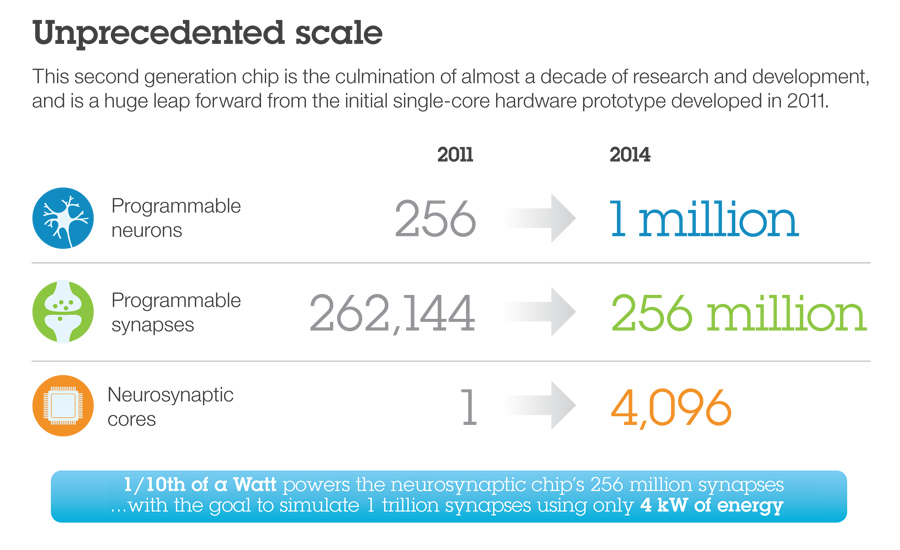
IBM’s splashy new “brain” chip, TrueNorth, is actually nothing like a real human brain — it’s not going to admire the pointillistic works of Van Gogh, much less fall in love with you before absconding to frolic with a new race of godlike machine beings ala Her — but it is a remarkable-sounding next step in the direction of brain-like computers that mimic the synaptic conversation actual brains have been having for eons.
The chip, designed over the past decade and part of IBM’s TrueNorth computing architecture, is detailed in the August 8 issue of Science, and it’s based on a principle that’s been around for decades known as neuromorphic engineering. That’s a fancy way of describing a system that mimics the biological nervous system, including (though not limited to) biological brains.
TrueNorth is IBM’s stab at a neuromorphic processor, something its authors describe as an “efficient, scalable and flexible non-von Neumann architecture.” John von Neumann came up with the basic architecture for how you’d go about running a digital processor in the 1940s, and it’s that essentially linear notion that forms the basis for the computers we’re still using today.
But linearity has its disadvantages: today’s processors are epically faster than human brains at crunching massively complex mathematical equations, say simulating weather patterns or calculating all the gravitational vectors involved in soft-landing a rover on Mars. But they’re utterly dimwitted at attempting contextual feats we humans perform with ease, say picking a voice out of a crowd or deciding which type of wine goes best with a meal.
That’s where the notion of brain-like parallelism comes in, itself a well-established idea in computing, but TrueNorth is about scaling it to unprecedented levels. The processor simulates a brain with one million neurons and 256 million synapses — about the crunch-power of a honey bee or cockroach — fueled by an on-chip network of 4,096 neurosynaptic cores. That adds up to a 5.4 billion transistor processor — the largest chip IBM’s yet built — but one that sips a mere 70 milliwatts of power during realtime operations, or four orders of magnitude fewer than conventional chips today. Altogether, the chip can perform 46 billion synaptic operations per second, per watt, says IBM.

Think of it as a little like the old left brain, right brain relationship: language and analytic thinking are left (von Neumann architecture) while sense and pattern recognition are right (neuromorphic processors). And that’s just the start, says IBM, noting that in the years to come, it hopes to bring the two together “to create a holistic computing intelligence.”
While we’re waiting for our holistic machine overlords to take over, what can TrueNorth do after developers have figured out what to design for it? How about improving visual and auditory tasks traditional computers presently stumble over?
As IBM Fellow Dharmendra Modha writes, “The architecture can solve a wide class of problems from vision, audition, and multi-sensory fusion, and has the potential to revolutionize the computer industry by integrating brain-like capability into devices where computation is constrained by power and speed.” Notice the way Modha describes the chips as complementary: the strategy with TrueNorth out of the gate looks to be integrative rather than one of displacing the processors in our smartphones, tablets and laptop computers.
Again, it’s important to bear in mind that TrueNorth isn’t a brain. As Modha himself notes, “we have not built the brain, or any brain. We have built a computer that is inspired by the brain.” But it’s an important step forward: another rung on a ladder that’s as high as our hopes of perhaps someday creating computer-like beings in our own image, or ones better still.
More Must-Reads from TIME
- Breaking Down the 2024 Election Calendar
- How Nayib Bukele’s ‘Iron Fist’ Has Transformed El Salvador
- What if Ultra-Processed Foods Aren’t as Bad as You Think?
- How Ukraine Beat Russia in the Battle of the Black Sea
- Long COVID Looks Different in Kids
- How Project 2025 Would Jeopardize Americans’ Health
- What a $129 Frying Pan Says About America’s Eating Habits
- The 32 Most Anticipated Books of Fall 2024
Write to Matt Peckham at matt.peckham@time.com